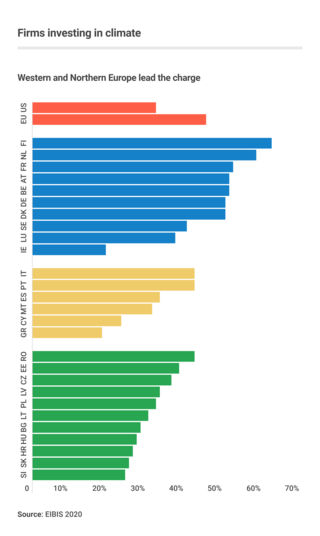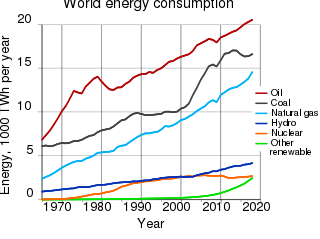Related Research Articles

Natural gas is a naturally occurring mixture of gaseous hydrocarbons consisting primarily of methane (97%) in addition to various smaller amounts of other higher alkanes. Low levels of trace gases like carbon dioxide, nitrogen, hydrogen sulfide, and helium are also usually present. Methane is colorless and odorless, and the second largest greenhouse gas contributor to global climate change after carbon dioxide. Because natural gas is odorless, odorizers such as mercaptan are commonly added to it for safety so that leaks can be readily detected.

Climate change mitigation is action to limit climate change. This action either reduces emissions of greenhouse gases or removes those gases from the atmosphere. The recent rise in global temperature is mostly due to emissions from burning fossil fuels such as coal, oil, and natural gas. There are various ways that mitigation can reduce emissions. These are transitioning to sustainable energy sources, conserving energy, and increasing efficiency. It is possible to remove carbon dioxide from the atmosphere. This can be done by enlarging forests, restoring wetlands and using other natural and technical processes. The name for these processes is carbon sequestration. Governments and companies have pledged to reduce emissions to prevent dangerous climate change. These pledges are in line with international negotiations to limit warming.

Business action on climate change includes a range of activities relating to climate change, and to influencing political decisions on climate change-related regulation, such as the Kyoto Protocol. Major multinationals have played and to some extent continue to play a significant role in the politics of climate change, especially in the United States, through lobbying of government and funding of climate change deniers. Business also plays a key role in the mitigation of climate change, through decisions to invest in researching and implementing new energy technologies and energy efficiency measures.
The Investor Network on Climate Risk (INCR) is a nonprofit organization of investors and financial institutions that promotes better understanding of the financial risks and investment opportunities posed by climate change. INCR is coordinated by Ceres, a coalition of investors and environmental groups working to advance sustainable prosperity.

Greenhouse gas (GHG) emissions from human activities intensify the greenhouse effect. This contributes to climate change. Carbon dioxide, from burning fossil fuels such as coal, oil, and natural gas, is one of the most important factors in causing climate change. The largest emitters are China followed by the United States. The United States has higher emissions per capita. The main producers fueling the emissions globally are large oil and gas companies. Emissions from human activities have increased atmospheric carbon dioxide by about 50% over pre-industrial levels. The growing levels of emissions have varied, but have been consistent among all greenhouse gases. Emissions in the 2010s averaged 56 billion tons a year, higher than any decade before. Total cumulative emissions from 1870 to 2017 were 425±20 GtC from fossil fuels and industry, and 180±60 GtC from land use change. Land-use change, such as deforestation, caused about 31% of cumulative emissions over 1870–2017, coal 32%, oil 25%, and gas 10%.

The United States produced 5.2 billion metric tons of carbon dioxide equivalent greenhouse gas (GHG) emissions in 2020, the second largest in the world after greenhouse gas emissions by China and among the countries with the highest greenhouse gas emissions per person. In 2019 China is estimated to have emitted 27% of world GHG, followed by the United States with 11%, then India with 6.6%. In total the United States has emitted a quarter of world GHG, more than any other country. Annual emissions are over 15 tons per person and, amongst the top eight emitters, is the highest country by greenhouse gas emissions per person. However, the IEA estimates that the richest decile in the US emits over 55 tonnes of CO2 per capita each year. Because coal-fired power stations are gradually shutting down, in the 2010s emissions from electricity generation fell to second place behind transportation which is now the largest single source. In 2020, 27% of the GHG emissions of the United States were from transportation, 25% from electricity, 24% from industry, 13% from commercial and residential buildings and 11% from agriculture. In 2021, the electric power sector was the second largest source of U.S. greenhouse gas emissions, accounting for 25% of the U.S. total. These greenhouse gas emissions are contributing to climate change in the United States, as well as worldwide.
New Energy for America was a plan led by Barack Obama and Joe Biden beginning in 2008 to invest in renewable energy sources, reduce reliance on foreign oil, address global warming issues, and create jobs for Americans. The main objective of the New Energy for America plan was to implement clean energy sources in the United States to switch from nonrenewable resources to renewable resources. The plan led by the Obama Administration aimed to implement short-term solutions to provide immediate relief from pain at the pump, and mid- to- long-term solutions to provide a New Energy for America plan. The goals of the clean energy plan hoped to: invest in renewable technologies that will boost domestic manufacturing and increase homegrown energy, invest in training for workers of clean technologies, strengthen the middle class, and help the economy.

BP p.l.c. is a British multinational oil and gas company headquartered in London, England. It is one of the oil and gas "supermajors" and one of the world's largest companies measured by revenues and profits. It is a vertically integrated company operating in all areas of the oil and gas industry, including exploration and extraction, refining, distribution and marketing, power generation, and trading.
The milestones for carbon capture and storage show the lack of commercial scale development and implementation of CCS over the years since the first carbon tax was imposed.

The environmental impact of the energy industry is significant, as energy and natural resource consumption are closely related. Producing, transporting, or consuming energy all have an environmental impact. Energy has been harnessed by human beings for millennia. Initially it was with the use of fire for light, heat, cooking and for safety, and its use can be traced back at least 1.9 million years. In recent years there has been a trend towards the increased commercialization of various renewable energy sources. Scientific consensus on some of the main human activities that contribute to global warming are considered to be increasing concentrations of greenhouse gases, causing a warming effect, global changes to land surface, such as deforestation, for a warming effect, increasing concentrations of aerosols, mainly for a cooling effect.
The climate change policy of the United States has major impacts on global climate change and global climate change mitigation. This is because the United States is the second largest emitter of greenhouse gasses in the world after China, and is among the countries with the highest greenhouse gas emissions per person in the world. In total, the United States has emitted over a trillion metric tons of greenhouse gasses, more than any country in the world.
Brazil has established a strong public policy using Clean Development Mechanism Projects to reduce methane emissions from landfills. An important component of these projects is the sale of avoided emissions by the private market to generate revenue.

Climate change has resulted in an increase in temperature of 2.3 °C (2022) in Europe compared to pre-industrial levels. Europe is the fastest warming continent in the world. Europe's climate is getting warmer due to anthropogenic activity. According to international climate experts, global temperature rise should not exceed 2 °C to prevent the most dangerous consequences of climate change; without reduction in greenhouse gas emissions, this could happen before 2050. Climate change has implications for all regions of Europe, with the extent and nature of impacts varying across the continent.

The Climate and Clean Air Coalition to Reduce Short-Lived Climate Pollutants (CCAC) was launched by the United Nations Environment Programme (UNEP) and six countries—Bangladesh, Canada, Ghana, Mexico, Sweden, and the United States—on 16 February 2012. The CCAC aims to catalyze rapid reductions in short-lived climate pollutants to protect human health, agriculture and the environment. To date, more than $90 million has been pledged to the Climate and Clean Air Coalition from Canada, Denmark, the European Commission, Germany, Japan, the Netherlands, Norway, Sweden, and the United States. The program is managed out of the United Nations Environmental Programme through a Secretariat in Paris, France.

Sultan Ahmed Al Jaber, is an Emirati politician who is the minister of industry and advanced technology of the United Arab Emirates, head of the Abu Dhabi National Oil Company (ADNOC), and chairman of Masdar.

SensorUp Inc. is a Canadian company based in Calgary, Alberta, Canada, specializing in methane emissions management software. It is recognized for its advancements in the oil and gas sector with its methane emissions management SaaS platform, SensorUp GEMS, and for developing the Open Geospatial Consortium SensorThings API standard specification.

Gas venting, more specifically known as natural-gas venting or methane venting, is the intentional and controlled release of gases containing alkane hydrocarbons - predominately methane - into Earth's atmosphere. It is a widely used method for disposal of unwanted gases which are produced during the extraction of coal and crude oil. Such gases may lack value when they are not recyclable into the production process, have no export route to consumer markets, or are surplus to near-term demand. In cases where the gases have value to the producer, substantial amounts may also be vented from the equipment used for gas collection, transport, and distribution.

The Washington Carbon Emissions Fee and Revenue Allocation Initiative, also known as Initiative 1631 or the Protect Washington Act was a ballot initiative that appeared on ballots in the State of Washington in the November 2018 election. The initiative proposed to reduce pollution by levying a fee on greenhouse gas emissions generated within the state of Washington, and using that revenue to support air quality and energy projects, as well as water quality and forest health initiatives. The measure failed with 56.3% of voters rejecting it. As of 2018, more had been spent in campaigning for and against the initiative than on any other ballot measure in Washington history.

Coal, cars and lorries vent more than a third of Turkey's six hundred million tonnes of annual greenhouse gas emissions, which are mostly carbon dioxide and part of the cause of climate change in Turkey. The nation's coal-fired power stations emit the most carbon dioxide, and other significant sources are road vehicles running on petrol or diesel. After coal and oil the third most polluting fuel is fossil gas; which is burnt in Turkey's gas-fired power stations, homes and workplaces. Much methane is belched by livestock; cows alone produce half of the greenhouse gas from agriculture in Turkey.

Routine flaring, also known as production flaring, is a method and current practice of disposing of large unwanted amounts of associated petroleum gas (APG) during crude oil extraction. The gas is first separated from the liquids and solids downstream of the wellhead, then released into a flare stack and combusted into Earth's atmosphere. Where performed, the unwanted gas has been deemed unprofitable, and may be referred to as stranded gas, flare gas, or simply as "waste gas". Routine flaring is not to be confused with safety flaring, maintenance flaring, or other flaring practices characterized by shorter durations or smaller volumes of gas disposal.
References
- 1 2 3 4 5 6 7 8 9 10 11 12 "Oil and Gas Climate Initiative announces progress towards methane target and new CCUS initiative to scale up actions towards climate goals". OGCI. September 23, 2019. Retrieved October 17, 2019.
- 1 2 3 4 5 6 7 8 Gosden, Emily (November 2, 2016). "Oil chiefs try to boost green credentials with new investment fund". The Telegraph. ISSN 0307-1235 . Retrieved October 17, 2019.
- 1 2 3 4 5 Laville, Sandra (September 18, 2019). "'Greenwashing': fossil fuel execs to hold invite-only forum at UN climate summit". The Guardian. ISSN 0261-3077 . Retrieved October 17, 2019.
- ↑ "Paris Climate Agreement Becomes International Law". ABC News. Archived from the original on 4 November 2016. Retrieved 4 November 2016.
- 1 2 Tabuchi, Hiroko (October 16, 2019). "Despite Their Promises, Giant Energy Companies Burn Away Vast Amounts of Natural Gas". The New York Times. ISSN 0362-4331 . Retrieved October 17, 2019.
- ↑ "Natural Gas Flaring and Venting: State and Federal Regulatory Overview, Trends, and Impacts" (PDF). U.S. Department of Energy. June 1, 2019. Retrieved December 31, 2019.
- ↑ Nick Cunningham (December 14, 2019). "Emissions Soar As Permian Flaring Frenzy Breaks New Records". Oilprice.com. Retrieved December 31, 2019.
- 1 2 "The largest US carbon capture and sequestration project to be developed by Wabash Valley Resources with funding support from OGCI Climate Investments". PRNewswire. Terre Haute, Indiana. May 20, 2019. Retrieved October 17, 2019.
- ↑ "SeekOps Secures Venture Funding To Scale Drone-Based Emissions Systems". September 10, 2019. Retrieved October 17, 2019.